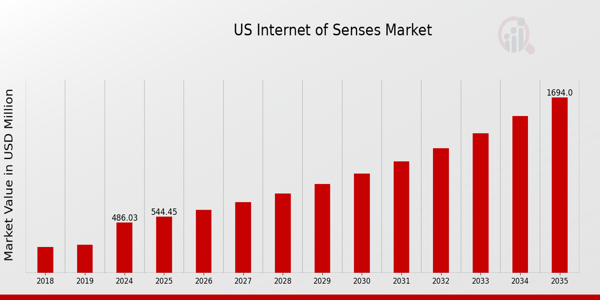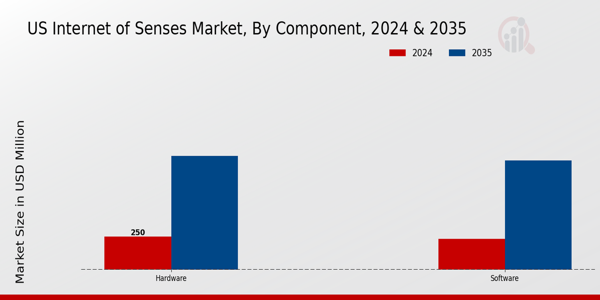US Internet of Senses Market Overview
As per MRFR analysis, the US Internet of Senses Market Size was estimated at 431.64 (USD Million) in 2023. The US Internet of Senses Market is expected to grow from 486.03 (USD Million) in 2024 to 1,694.07 (USD Million) by 2035. The US Internet of Senses Market CAGR (growth rate) is expected to be around 12.02% during the forecast period (2025 - 2035).
Key US Internet of Senses Market Trends Highlighted
Due to rising consumer desire for immersive experiences and technological improvements, the US Internet of Senses market is expanding significantly. The growth of virtual and augmented reality applications in industries including gaming, education, and healthcare are important market drivers.
Businesses are making significant investments in developing sensory-rich spaces that better engage users as these technologies become more ingrained in daily life. Additionally, the widespread use of IoT devices improves experience customisation and makes it easier for users to engage with digital material.
Brands are using sound, touch, and smell in addition to visual components to create stronger connections with their target audience, demonstrating a noticeable trend in recent years toward the inclusion of multisensory experiences in marketing efforts.
The increasing understanding of the significance of sensory experiences in shaping consumer behavior lends support to this tendency. Furthermore, the US government is actively supporting sensory technology research and development by offering funds and other resources to encourage creativity and cooperation between businesses and universities.
There are several opportunities in the US market, particularly for firms specializing in cutting-edge technologies that integrate data analytics, artificial intelligence, and sensory experiences. Investigating cutting-edge Internet of Senses applications can result in specialized markets and new consumer segments as companies look to stand out in a congested market.
As more people look for linked solutions that improve their quality of life, the growing trend toward smart home gadgets also offers a useful avenue. All things considered, the US IoS market is evolving and has lots of room to expand and innovate.

Source: Primary Research, Secondary Research, MRFR Database and Analyst Review
US Internet of Senses Market Drivers
Technological Advancements in Sensory Devices
The ongoing advancements in technology, particularly in sensory devices, play a crucial role in the growth of the US Internet of Senses Market. As per the US Department of Commerce, investment in Research and Development (R&D) within the electronics sector has increased significantly, with a growth rate of approximately 6.5% year-over-year over the last five years.
This investment bolsters the development of advanced sensory devices, such as enhanced olfactory and taste sensors, which are expected to transform consumer experiences in various sectors, including entertainment, healthcare, and food and beverage industries.Established organizations like Google and Apple are continually innovating in this space, developing smart devices that integrate advanced sensory technologies.
For instance, the integration of Augmented Reality (AR) and Virtual Reality (VR) into sensory experiences is projected to enhance user engagement significantly, creating a notable demand in the market and further solidifying the United States' position as a leader in technology.
Increasing Demand for Immersive Experiences
The rising consumer trend towards immersive experiences is a significant market driver for the US Internet of Senses Market. The Entertainment Software Association reported that 75% of consumers are seeking more interactive and immersive experiences, a trend that has been accelerated due to the COVID-19 pandemic.
As consumers spend more time at home, the interest in home entertainment systems that utilize sensory technologies is rising. Companies such as Microsoft and Sony have adapted their product offerings to include more immersive gaming experiences, utilizing the Internet of Senses technologies. This shift reflects consumer preferences and indicates strong growth potential in this market sector.
Healthcare Innovations and Applications
Innovations in the healthcare sector are significantly driving the US Internet of Senses Market. The American Medical Association has noted a surge in telehealth services, which have increased by 154% during the pandemic. The use of sensory technologies in telehealth offers enhanced patient experiences and improved diagnostics.
Companies like Philips and Siemens Healthineers are developing innovative solutions that integrate sensory applications that help healthcare providers monitor patient conditions remotely. With nearly 20% of the US population over 65 years old, the demand for accessible healthcare services that include sensory technologies is likely to see continued growth, thus propelling the market forward.
Growth of Consumer Electronics Sector
The robust expansion of the consumer electronics sector is a pivotal driver for the US Internet of Senses Market. The Consumer Technology Association reported that consumer electronics sales in the United States reached a record high, with an expected growth rate of 10% annually in the next few years.This growth is majorly attributed to the increasing adoption of smart devices that incorporate sensory technology for enriched user experiences.
Companies like Samsung and LG are continuously innovating by introducing new products that utilize advanced sensory features, aligning with the evolving consumer preferences for more sophisticated technology. As the consumer electronics market thrives, it creates a ripple effect, nurturing the Internet of Senses market's growth significantly.
US Internet of Senses Market Segment Insights
Internet of Senses Market Component Insights
The Component segment of the US Internet of Senses Market encompasses essential elements that play a pivotal role in the development and delivery of sensory experiences through technology. This segment can broadly be categorized into Hardware and Software, each contributing uniquely to the market's evolution.
Hardware includes devices and sensors that interact with users' senses, enabling experiences that mimic or enhance realities. These tangible components are critical in creating immersive environments, which are increasingly sought after in entertainment, healthcare, and education.
On the other hand, Software provides the necessary algorithms and interfaces that allow the hardware to interpret, process, and deliver sensory data effectively. This duality is essential for driving innovation within the Internet of Senses ecosystem, as advancements in software can dramatically enhance the functionality of hardware while creating new use cases across various industries.
In the U.S., the focus on digital innovation and smart technologies has led to significant investment in these components, particularly as businesses strive for differentiation in increasingly crowded marketplaces.Factors such as a growing demand for enhanced user engagement and the integration of virtual and augmented realities are propelling the Hardware segment forward, making it critical for businesses aiming to capture consumer interest.
Moreover, the Software aspect is vital in ensuring seamless usability and fostering user-friendly interactions, which are essential for mass adoption of Internet of Senses technologies.As companies seek to leverage these components, the development of robust, interconnected systems becomes paramount, leading to an increase in demand for sophisticated, interoperable hardware and software solutions that enhance sensory experiences.
The U.S. government encourages technological advancements through various initiatives that support innovation in the Internet of Senses domain, recognizing its potential to influence sectors such as health care, where immersive experiences can aid in pain management, rehabilitation, and mental health therapies.Challenges also persist, such as ensuring compatibility across devices and maintaining security and privacy standards, which are essential for consumer trust. However, the vast opportunities for creating compelling, sensory-driven experiences position the Component segment as a cornerstone for growth within the US Internet of Senses Market.
With ongoing advancements and a significant focus on user-centric design, both Hardware and Software are poised to play crucial roles in shaping the future landscape of sensory technology.

Source: Primary Research, Secondary Research, MRFR Database and Analyst Review
Internet of Senses Market Technology Insights
The US Internet of Senses Market is undergoing significant growth within the Technology segment, driven by advancements in various domains including Artificial Intelligence, Virtual Reality, and Augmented Reality. Artificial Intelligence is playing a crucial role, enhancing user experience by enabling systems to interact and respond to sensory inputs more efficiently.
Meanwhile, Virtual Reality enables immersive experiences that engage multiple senses, making it a vital tool in entertainment, education, and training sectors. Augmented Reality provides an overlay of digital information on the real world, which is increasingly being adopted in retail and marketing to enhance customer engagement.
The rising demand for these technologies is fueled by an increasing focus on interactive environments and personalized consumer experiences. Additionally, the Others category includes various emerging technologies that complement and enrich user interactions, contributing to diversification in the market.
Collectively, these segments highlight the importance of innovative technology in defining the future of sensory interaction, transforming how users perceive and engage with digital content in the US context. The ongoing investments in Research and Development are expected to strengthen these areas further, driving market growth and expanding opportunities across industries.
Internet of Senses Market Application Insights
The US Internet of Senses Market focuses on various applications that enhance human experiences through advanced sensory technologies. Each applicationHearing, Sight, Smell, Taste, Touch, and Mindplays a vital role in shaping how users interact with digital content and the physical world.
The Hearing application significantly enhances communication, enabling advanced hearing aids and immersive audio experiences, which are increasingly vital in an aging demographic. Likewise, the Sight application is critical for virtual and augmented realities, enhancing both entertainment and educational experiences.
The Smell and Taste applications offer exciting possibilities in food technology and digital marketing, allowing consumers to enjoy a multi-sensory experience that can influence purchasing decisions. The Touch application stands central in the development of haptics technology, vital for creating realistic interactions in gaming and remote communication.
Lastly, the Mind application represents the intersection of technology and cognitive functions, leading to advancements in mental health and user engagement. The growing integration of these sensory applications highlights the market's potential, driven by increasing consumer demand for immersive experiences, personalization, and innovative user interfaces within the US.
Internet of Senses Market End User Insights
The End User segment of the US Internet of Senses Market plays a crucial role in shaping the industry's trajectory, with major contributions from Consumer, Enterprise, and Retail sectors. The Consumer segment significantly drives market innovation, focusing on enhanced user experiences and new immersive technologies such as virtual reality and augmented reality applications.
The Enterprise segment is also vital, as companies leverage Internet of Senses technologies to improve productivity and communication, integrating sophisticated sensory inputs into everyday operational processes.The Retail sector is transforming the shopping experience by utilizing sensory marketing strategies that engage consumers' senses, promoting products through sight, sound, and touch for deeper emotional connections. Each of these segments holds a predominant position in the overall market, reflecting the growing importance of sensory-enhanced experiences across various domains.
As trends evolve towards personalization and engagement, the demand for innovative applications within these segments is expected to witness substantial growth, presenting over numerous opportunities while also facing challenges such as data privacy and ethical considerations.
US Internet of Senses Market Key Players and Competitive Insights
The US Internet of Senses Market is an emerging and rapidly evolving sector that leverages advanced technologies such as virtual reality, augmented reality, and sensory experiences to create a more immersive and interactive digital environment.This market is characterized by its potential to revolutionize how users interact with digital content, engaging multiple senses beyond sight and hearing to include touch, taste, and smell. As advancements in hardware and software continue to accelerate, the competitive landscape is becoming increasingly dynamic, with numerous key players vying for market share.
Innovations in sensory technology, coupled with the growing adoption of Internet of Things appliances, are paving the way for new applications in various industries, including gaming, education, healthcare, and entertainment. This competitive environment is driven by a combination of established tech giants and nimble start-ups that are pushing the boundaries of sensory technology and customer experience.
NVIDIA is a prominent entity in the US Internet of Senses Market, known for its cutting-edge graphics processing technology and AI solutions. The company has established a strong market presence by providing high-performance platforms that enhance visual and sensory experiences in the realm of virtual and augmented reality.
NVIDIA's strengths lie in its robust R&D capabilities, which enable continuous innovation in real-time rendering and machine learning applications, making it a pivotal player in delivering immersive experiences.By focusing on developing the necessary hardware and software ecosystems for the Internet of Senses, NVIDIA has positioned itself as a leader in transforming how sensory details can be rendered and experienced, enhancing user engagement across various applications.
Its collaborations with other tech companies and developers further enhance its competitive edge, facilitating the integration of its technologies into broader sensory platforms.Immersion Corporation specializes in haptic technology and sensory solutions that enhance user experiences by simulating the sense of touch in digital interactions. Within the US Internet of Senses Market, Immersion Corporation is known for its innovative products that provide tactile feedback, making digital environments feel more realistic and engaging.
Key offerings include haptic software development tools and hardware that integrate seamlessly into various devices, ranging from smartphones to gaming consoles. The company has cultivated a strong market presence through strategic partnerships and collaborations, aiming to expand the applicability of its haptic technology across diverse sectors such as gaming, automotive, and healthcare.
Immersion Corporation’s strengths lie in its pioneering research and development in the haptic space, bolstered by a history of successful mergers and acquisitions that have broadened its technological capabilities and market reach in the United States.The continuous evolution of its products positions Immersion Corporation as a significant player in enhancing the sensory capabilities of digital platforms within the rapidly growing Internet of Senses ecosystem.
Key Companies in the US Internet of Senses Market Include:
- NVIDIA
- Immersion Corporation
- Google
- Unity Technologies
- Mozilla
- Apple
- Meta Platforms
- Cisco Systems
- Samsung Electronics
- IBM
- Amazon
- Sony
- Qualcomm
- Microsoft
- WaveOptics
US Internet of Senses Market Developments
The Avatar Cloud Engine (ACE) for Games, a collection of AI models designed to give non-playable characters (NPCs) realistic motions and natural language exchanges, was unveiled by NVIDIA in May 2023. An important step toward incorporating generative AI into game experiences was taken with this development.
In order to improve the efficacy of its advertising networks and enhance user experience by removing fraudulent interactions, Google stated in August 2025 that it would be implementing big language models to tackle bogus ad traffic.Apple introduced new Apple Intelligence features for the iPhone, iPad, Mac, Apple Watch, and Apple Vision Pro during its Worldwide Developers Conference (WWDC) in June 2025. The goal of these improvements is to offer more intelligent and customized user experiences.
The goal of Meta Platforms has been to include augmented reality into its products. The business announced plans to launch a new software platform for its AR glasses in August 2025 with the goal of facilitating the creation of AR applications and enhancing user engagement.In order to meet the increasing demands of AI applications, Cisco Systems has been rethinking network architectures. In an effort to manage growing data volumes and improve network performance, Cisco unveiled new technologies in February 2025 that would allow service providers to offer AI connectivity.
With an emphasis on developing more immersive, intelligent, and interactive experiences across several sectors, these innovations show a strong commitment from U.S.-based enterprises to advance the Internet of Senses industry.
Internet of Senses Market Segmentation Insights
Internet of Senses Market Component Outlook
Internet of Senses Market Technology Outlook
- Artificial Intelligence
- Virtual Reality
- Augmented Reality
- Others
Internet of Senses Market Application Outlook
- Hearing
- Sight
- Smell
- Taste
- Touch
- Mind
Internet of Senses Market End User Outlook
- Consumer
- Enterprise
- Retail
|
Report Attribute/Metric
|
Details
|
|
Market Size 2023
|
431.64(USD Million)
|
|
Market Size 2024
|
486.03(USD Million)
|
|
Market Size 2035
|
1694.07(USD Million)
|
|
Compound Annual Growth Rate (CAGR)
|
12.02% (2025 - 2035)
|
|
Report Coverage
|
Revenue Forecast, Competitive Landscape, Growth Factors, and Trends
|
|
Base Year
|
2024
|
|
Market Forecast Period
|
2025 - 2035
|
|
Historical Data
|
2019 - 2024
|
|
Market Forecast Units
|
USD Million
|
|
Key Companies Profiled
|
NVIDIA, Immersion Corporation, Google, Unity Technologies, Mozilla, Apple, Meta Platforms, Cisco Systems, Samsung Electronics, IBM, Amazon, Sony, Qualcomm, Microsoft, WaveOptics
|
|
Segments Covered
|
Component, Technology, Application, End User
|
|
Key Market Opportunities
|
Immersive consumer experiences, Enhanced remote collaboration tools, Smart healthcare applications, Interactive gaming advancements, Personalized marketing strategies
|
|
Key Market Dynamics
|
Sensory technology advancements, Increasing consumer demand, Enhanced user experiences, Integration with AI, Growth in wearable devices
|
|
Countries Covered
|
US
|
Frequently Asked Questions (FAQ):
The market size of the US Internet of Senses Market in 2024 was valued at 486.03 million USD.
By 2035, the US Internet of Senses Market is expected to reach a value of 1694.07 million USD.
The projected CAGR for the US Internet of Senses Market from 2025 to 2035 is 12.02%.
In 2035, the hardware segment of the US Internet of Senses Market is expected to be valued at 865.0 million USD.
The software segment of the US Internet of Senses Market was valued at 236.03 million USD in 2024.
Key players in the US Internet of Senses Market include NVIDIA, Google, Apple, Meta Platforms, and Microsoft, among others.
Growth drivers for the US Internet of Senses Market include advancements in technology and increasing demand for immersive experiences.
The US Internet of Senses Market is evolving to include applications in virtual reality, augmented reality, and sensory enhancements.
The key competitors in the US Internet of Senses Market hold significant shares due to their established technologies and innovation.
The hardware segment of the US Internet of Senses Market was valued at 250.0 million USD in 2024.
















